Thien Mu Pagoda in Hue, nestled on the banks of the Perfume River, stands as a timeless symbol of spirituality, history, and architectural beauty in Central Vietnam.
Known as one of the most iconic landmarks in Hue, this ancient pagoda has witnessed centuries of cultural and political shifts, making it a must-visit destination for travelers seeking to explore Vietnam’s rich heritage. In this comprehensive guide, we’ll take you on a journey through the serene beauty of Thien Mu Pagoda in Hue, uncovering its history, architectural marvels, and practical tips for an unforgettable visit.
1. Discovering the Location of Thien Mu Pagoda in Hue, Vietnam: How to Reach This Sacred Site
Thien Mu Pagoda in Hue is located in An Ninh Thuong village, Huong Long Ward, on the northern bank of the Perfume River (Song Huong), approximately 5 kilometers west of Hue’s city center in Thua Thien Hue Province, Central Vietnam. Perched on Ha Khe Hill, the pagoda offers breathtaking views of the river and the surrounding lush greenery, creating a serene and spiritual atmosphere that captivates visitors.
How to Get to Thien Mu Pagoda in Hue:
Reaching Thien Mu Pagoda in Hue is easy, with several transportation options available depending on your starting point and preferences:
- By Bicycle or Motorbike: One of the most scenic ways to reach Thien Mu Pagoda in Hue is by renting a bicycle or motorbike from Hue’s city center. The 5-kilometer journey takes about 15–20 minutes by motorbike or 30–40 minutes by bicycle. Follow Kim Long Street westward along the Perfume River, passing through quaint villages and enjoying the picturesque scenery. This route is popular among tourists for its tranquility and the chance to experience local life.
- By Car or Taxi: If you prefer a more comfortable option, a taxi or private car from Hue’s city center to Thien Mu Pagoda in Hue costs around 100,000–150,000 VND (4–6 USD) one way. The drive takes about 10–15 minutes, making it a convenient choice for families or groups.
- By Boat: For a unique experience, consider taking a dragon boat tour along the Perfume River. Many boat tours in Hue include a stop at Thien Mu Pagoda in Hue as part of their itinerary, often combined with visits to other attractions like the Imperial City or the royal tombs. A boat trip typically costs 150,000–300,000 VND (6–12 USD) per person, depending on the duration and stops.
- By Cyclo: A traditional cyclo (rickshaw) ride is a charming way to travel to Thien Mu Pagoda in Hue. The ride takes about 20–30 minutes from the city center and costs around 100,000 VND (4 USD). It’s a leisurely option that allows you to soak in the sights and sounds of Hue.
- By Walking: If you’re staying near Kim Long Street or the Perfume River, walking to Thien Mu Pagoda in Hue is a viable option. The 5-kilometer walk takes about 1 hour and offers a chance to explore the local neighborhoods and riverside scenery.
No matter how you choose to travel, the journey to Thien Mu Pagoda in Hue is as enchanting as the destination itself, with the Perfume River’s gentle flow and Hue’s laid-back charm setting the tone for a memorable visit.
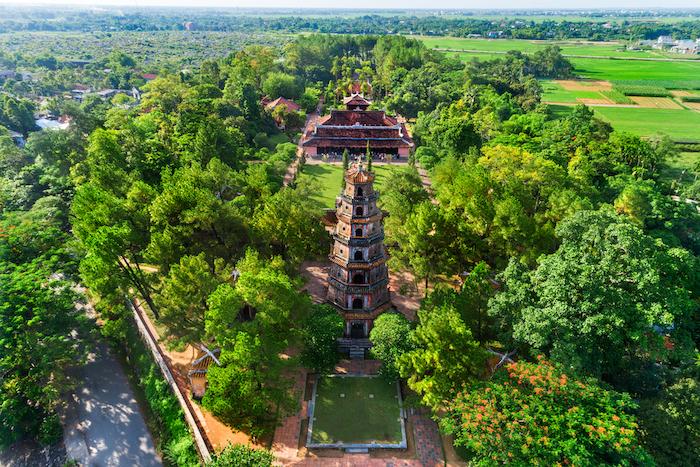
Thien Mu Pagoda is an iconic destination in Hue, Vietnam (Source: Collected)
2. Unveiling the Rich History of Thien Mu Pagoda in Hue
The history of Thien Mu Pagoda in Hue spans over four centuries, making it one of the oldest and most significant religious sites in Vietnam. The pagoda was founded in 1601 by Nguyen Hoang, the first Nguyen Lord, who played a pivotal role in expanding Vietnamese territory southward. According to legend, Nguyen Hoang was exploring the area when an elderly woman appeared to him on Ha Khe Hill. She prophesied that a lord would build a pagoda on this site, bringing prosperity to the land. Taking this as a divine sign, Nguyen Hoang ordered the construction of Thien Mu Pagoda, originally named “Thien Mu,” meaning “Celestial Lady,” in honor of the woman in the vision.
Initially a modest structure, Thien Mu Pagoda in Hue grew in prominence over the centuries. In 1665, the pagoda underwent its first major renovation under Lord Nguyen Phuc Tan, who expanded its grounds and added new structures. In 1710, Lord Nguyen Phuc Chu commissioned the casting of a massive bronze bell, known as the Dai Hong Chung, weighing over 3,000 kilograms and inscribed with Buddhist sutras. This bell, still housed in the pagoda, is considered a national treasure and can be heard up to 10 kilometers away when rung.
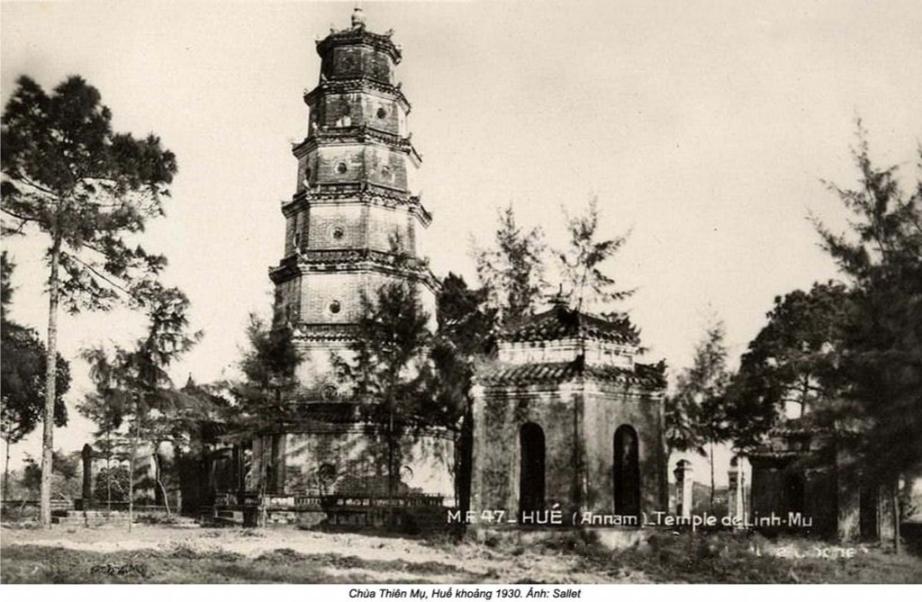
The photo of Thien Mu Pagoda in Hue was taken in 1930 (Source: Collected)
The pagoda’s iconic Phuoc Duyen Tower was added in 1844 by Emperor Thieu Tri of the Nguyen Dynasty. Standing 21 meters tall with seven stories, the tower became a symbol of Thien Mu Pagoda in Hue and a landmark of the city. Throughout the 19th and early 20th centuries, the pagoda underwent several renovations, particularly under the reigns of Emperors Gia Long and Minh Mang, who were devout Buddhists and patrons of the pagoda.
Thien Mu Pagoda in Hue also played a significant role in Vietnam’s modern history. During the 1960s, it became a center of Buddhist activism against the oppressive policies of the South Vietnamese government under President Ngo Dinh Diem. The pagoda gained international attention in 1963 when Thich Quang Duc, a monk from Thien Mu Pagoda, self-immolated in Saigon to protest religious persecution. The blue Austin car used to transport Thich Quang Duc to Saigon is now displayed at the pagoda, serving as a poignant reminder of this turbulent period.
Despite facing challenges, including damage from wars and natural disasters like typhoons, Thien Mu Pagoda in Hue has been meticulously preserved and restored. Today, it remains an active Buddhist monastery, home to monks who continue to practice and uphold the traditions of Vietnamese Buddhism.
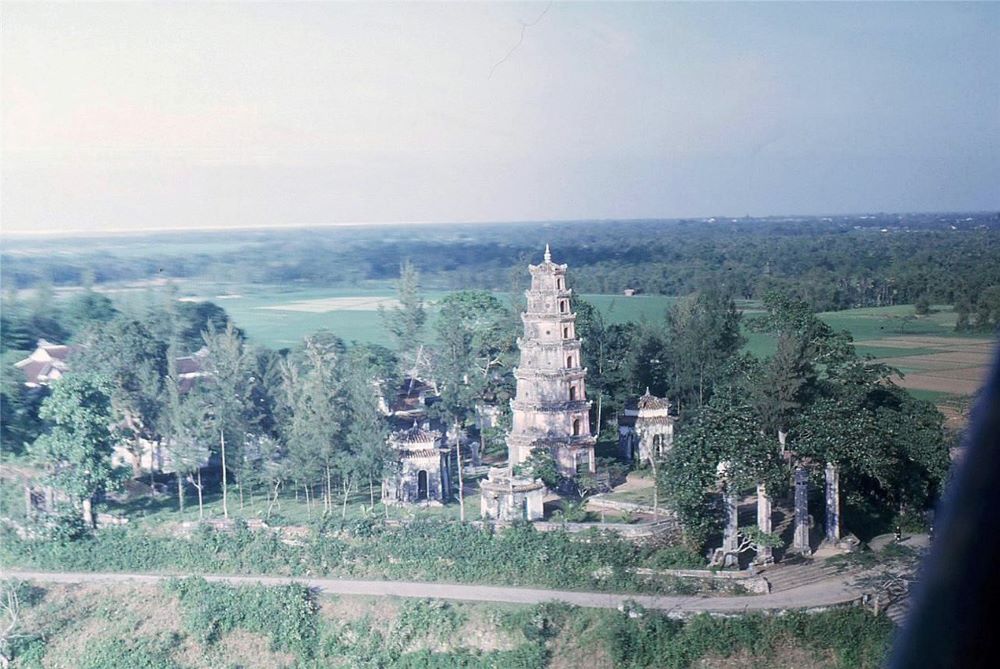
Thien Mu Pagoda is a prominent spiritual site deeply intertwined with history (Source: Collected)
3. Exploring the Architectural Marvels of Thien Mu Pagoda in Hue
Thien Mu Pagoda in Hue is a masterpiece of traditional Vietnamese architecture, blending Buddhist design principles with the natural beauty of its surroundings. The pagoda complex spans several hectares and includes a series of structures, each with its own historical and spiritual significance. Here are the architectural highlights you shouldn’t miss during your visit to Thien Mu Pagoda in Hue.
3.1. Tam Quan Gate: The Grand Entrance to Serenity
The Tam Quan Gate serves as the main entrance to Thien Mu Pagoda in Hue, welcoming visitors with its elegant three-arched design. This traditional Vietnamese gate, supported by sturdy pillars, is adorned with intricate carvings of lotus flowers and Buddhist symbols, reflecting the pagoda’s spiritual essence. The gate has two floors and eight roofs. Flanking the gate are two stone statues of guardian deities, known as “Dvarapala,” which are believed to protect the pagoda from evil spirits.
As you pass through the Tam Quan Gate, you’ll feel a sense of tranquility, marking the transition from the outside world to the sacred grounds of Thien Mu Pagoda in Hue.
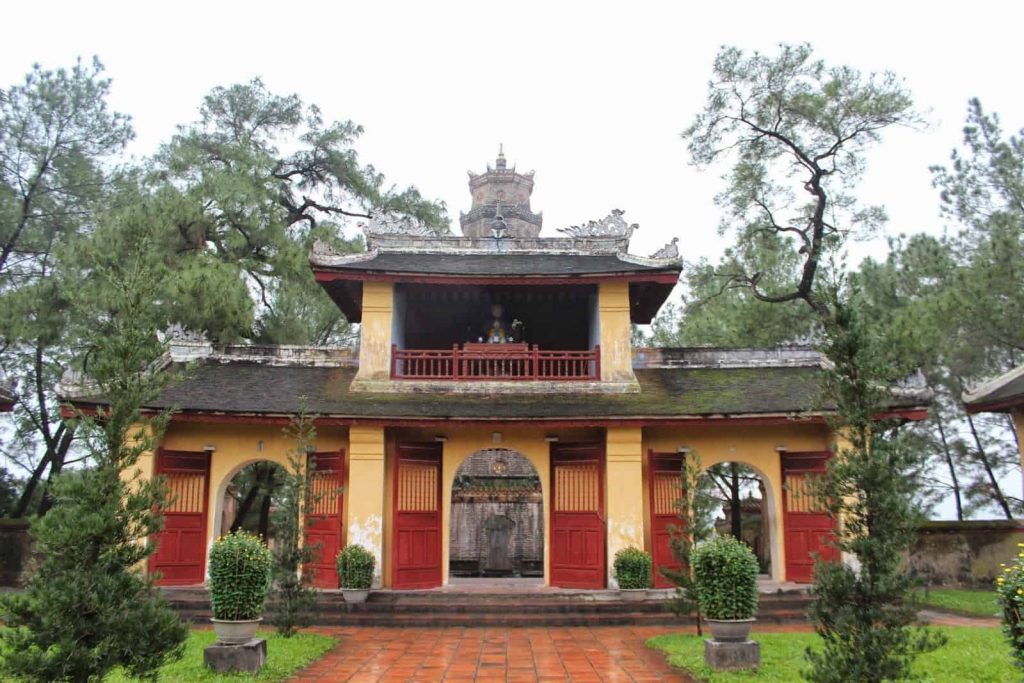
Distinctive patterns on Tam Quan Gate (Source: Collected)
3.2. Dai Hung Palace
Located in the main sanctuary of Thien Mu Pagoda in Hue, the Dai Hung Shrine is dedicated to the worship of Maitreya Buddha—the deity who embodies carefree joy and happiness. The statue of Maitreya is portrayed with a gentle demeanor, large attentive ears, a big belly symbolizing tolerance, and a warm, compassionate smile. The shrine is built entirely from solid concrete, but its exterior is painted to resemble natural wood, creating a sense of closeness and familiarity.
Beyond the statue of Maitreya, the Dai Hung Shrine also houses a large inscribed wooden plaque dating back to 1974 and a delicately crafted bronze bell adorned with sun and moon motifs. Further inside lies the inner sanctuary, where the central altar is dedicated to the Three Buddhas of the Past, Present, and Future. On the left stands a statue of the Bodhisattva Van Phu, while on the right is Pho Hien. Notably, the sacred ground behind the Dai Hung Shrine is the burial site of Venerable Thich Don Hau, the former abbot of the pagoda.
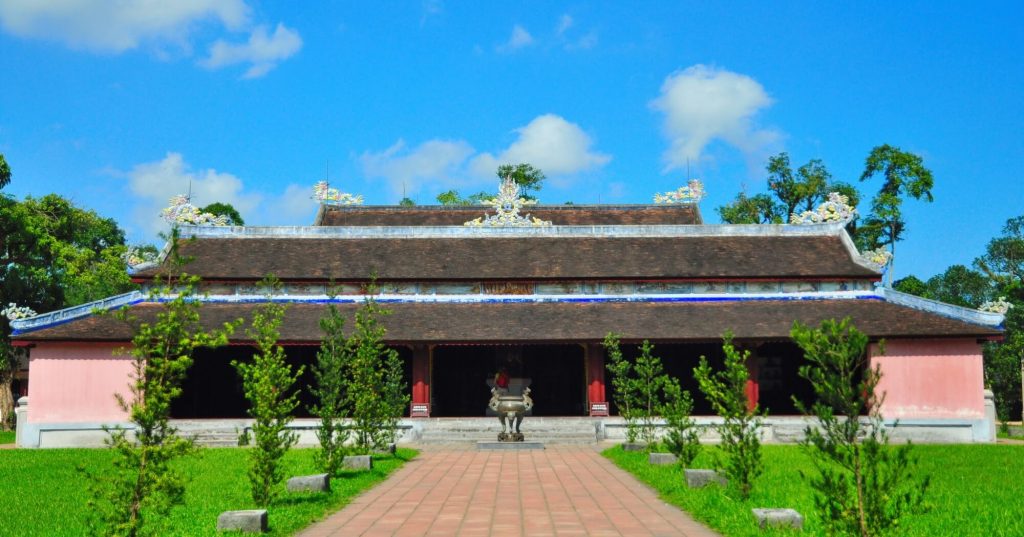
Dai Hung Shrine – The Main Sanctuary of Thien Mu Pagoda (Source: Collected)
3.3. Phuoc Duyen Tower: The Iconic Seven-Story Symbol
The Phuoc Duyen Tower is the most recognizable feature of Thien Mu Pagoda in Hue, often depicted in photographs and postcards of Hue. Built just behind the welcome gate, this structure is considered the “soul” of the pagoda. Together with the surrounding structures, it forms a harmonious architectural ensemble that is both distinctive and uniquely Hue in character.
Phuoc Duyen Tower was built in 1844 by King Thieu Tri on the occasion of the longevity ceremony of Queen Thuan Thien – the grandmother of King Thieu Tri. At first, it was named Tu Nhan Thap. Then it was changed to the current name. At that time, to complete the Tower, the clay, stones, and Bat Trang pottery materials had to be transferred from outside.
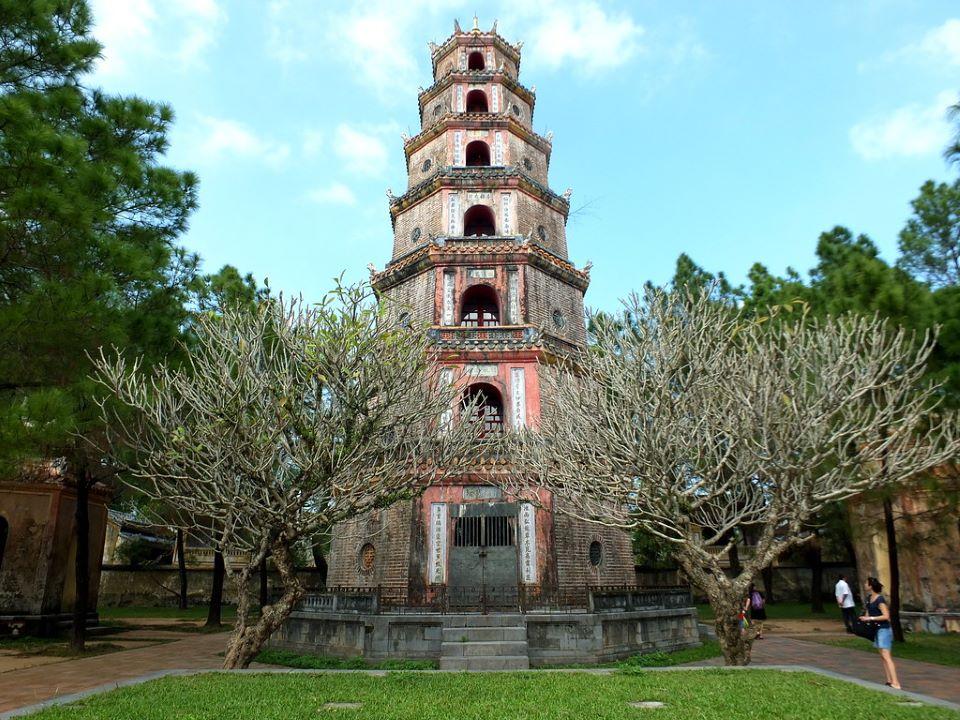
Phuoc Duyen Tower – The Spiritual Heart of Thien Mu Pagoda (Source: Collected)
The body of the tower is made from raw brick, while the edges are lined with finely carved Thanh stone. The structure takes the shape of an octagonal tower, narrowing as it rises, with a total of seven stories—each approximately two meters high. Each level follows the same design and is painted a soft pink color. Over the years, the tower has weathered with time, adding to the charm and historical value of this architectural gem in the former imperial capital.
3.4. Dia Tang Palace
Located behind the Dai Hung Palace, the Dia Tang Palace is a smaller hall dedicated to Ksitigarbha Bodhisattva, the guardian of the underworld in Buddhist tradition. This hall is a place of prayer for the souls of the deceased, offering solace to those seeking blessings for their loved ones. The Dia Tang Palace is adorned with statues of Ksitigarbha and his attendants, as well as intricate murals depicting scenes from Buddhist cosmology. The peaceful ambiance of this hall makes it a meaningful stop for those exploring the spiritual aspects of Thien Mu Pagoda in Hue.
3.5. Tomb of Venerable Thich Don Hau
The Tomb of Venerable Thich Don Hau, located within the pagoda grounds, honors one of the most respected monks of Thien Mu Pagoda in Hue. Thich Don Hau (1905–1991) served as the abbot of the pagoda for over 40 years and was a prominent figure in Vietnamese Buddhism, known for his contributions to education and charity. His tomb, a simple yet dignified structure, is surrounded by pine trees and features a stupa with his relics. Visitors often pay their respects here, lighting incense to honor the monk’s legacy at Thien Mu Pagoda in Hue.
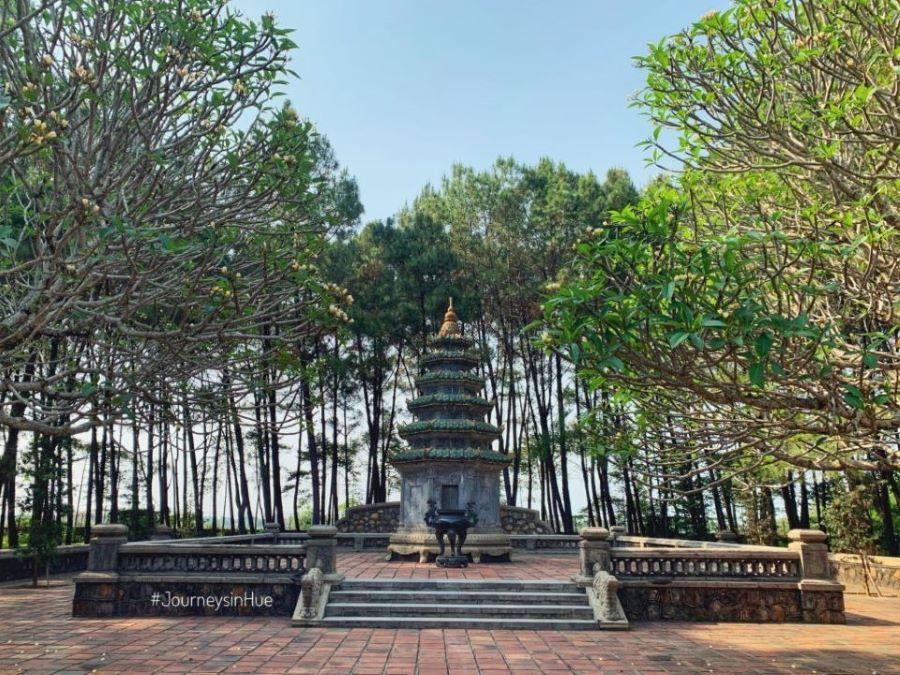
The stupa tomb of the late Venerable Thich Don Hau (@Photo: JourneysinHue)
3.6. The Sacred Garden and Relics
Beyond the main structures, Thien Mu Pagoda in Hue is home to a beautifully maintained garden filled with bonsai trees, lotus ponds, and stone statues. The garden provides a peaceful space for meditation and relaxation, with pathways leading to various relics, including the Dai Hong Chung bell and the blue Austin car used by Thich Quang Duc during his 1963 protest. These historical artifacts offer a deeper understanding of the pagoda’s role in Vietnam’s cultural and political history, making the garden a must-visit area of Thien Mu Pagoda in Hue.
4. A Practical Guide for Your Visit to Thien Mu Pagoda in Hue
To ensure a smooth and enriching experience at Thien Mu Pagoda in Hue, here’s a short guide with essential information and tips for your visit.
4.1. Opening Hours
Thien Mu Pagoda in Hue is open daily from 8:00 AM to 6:00 PM. It’s best to visit early in the morning to avoid crowds and enjoy the cool, peaceful atmosphere. Besides, if you want to admire the romantic sunset on the banks of the peaceful Huong River, please be there from 5:00 to 6:00 pm.
4.2. Entrance Fee
Admission to Thien Mu Pagoda in Hue is free of charge, making it an accessible destination for all travelers. However, donations are appreciated to support the pagoda’s maintenance and the monks’ activities. You may also need to budget for transportation costs, such as boat tours or taxi fares, to reach the pagoda.
4.3. Best Time to Visit
The best time to visit Thien Mu Pagoda in Hue is during the spring (February to April) or autumn (September to November), when the weather in Hue is pleasant, with mild temperatures and low humidity. Spring coincides with the Lunar New Year (Tet) and other festivals, adding a festive vibe to your visit. Avoid the rainy season (October to December), as heavy rains can make the pagoda grounds slippery and the Perfume River prone to flooding.
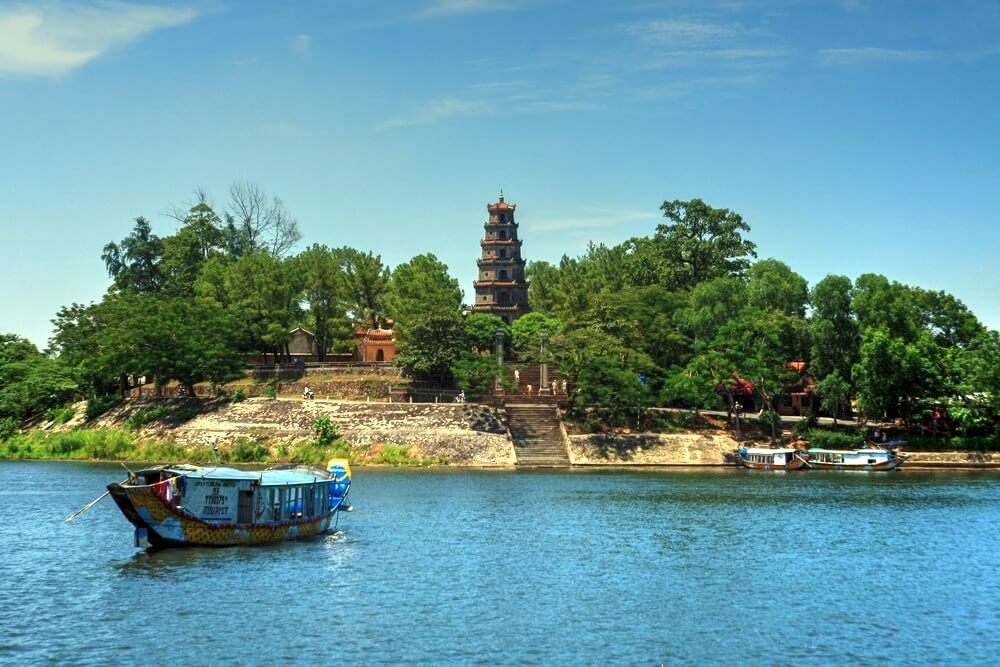
The breathtaking scenery at Thien Mu Pagoda (Photo: collected)
4.4. Dress Code and Etiquette
As a sacred Buddhist site, Thien Mu Pagoda in Hue requires visitors to dress modestly. Wear clothing that covers your shoulders and knees, and avoid revealing outfits. Remove your shoes before entering the main halls, and maintain a quiet, respectful demeanor during your visit. If you wish to light incense or make offerings, ask a monk for guidance to ensure you follow proper customs.
4.5. What to Bring
- Comfortable Shoes: The pagoda grounds involve some walking, and the stone steps to the Phuoc Duyen Tower can be uneven.
- Sun Protection: Hue can be hot, especially in summer (May to August). Bring a hat, sunglasses, and sunscreen.
- Camera: The pagoda’s architecture and riverside views are perfect for photography.
- Water and Snacks: While there are small vendors nearby, it’s a good idea to bring water, especially if you’re visiting during the hotter months.
4.6. Nearby Attractions to Combine with Your Visit
Thien Mu Pagoda in Hue is conveniently located near other iconic landmarks, making it easy to create a full-day itinerary:
- Hue Imperial City: Located 5 kilometers east of the pagoda, this UNESCO World Heritage Site was the seat of the Nguyen Dynasty from 1802 to 1945.
- Tomb of Emperor Tu Duc: About 7 kilometers from Thien Mu Pagoda, this tomb is a stunning example of Nguyen Dynasty architecture, set amidst pine forests and lakes.
- Perfume River Boat Tour: Extend your visit with a boat tour along the Perfume River, stopping at other pagodas and tombs along the way.

Hue Imperial City
4.7. Cultural Events at Thien Mu Pagoda
If your visit coincides with a Buddhist festival, such as Vesak Day (Buddha’s Birthday, typically in May), you’ll have the chance to witness special ceremonies at Thien Mu Pagoda in Hue. During Vesak, the pagoda is adorned with lanterns and flowers, and monks lead prayers and processions, creating a vibrant and spiritual atmosphere.
A visit to Thien Mu Pagoda in Hue is a journey through time, where the echoes of faith and history resonate in every corner of this sacred site. Plan your trip to Thien Mu Pagoda in Hue today and discover why this iconic landmark is one of Central Vietnam’s most cherished treasures. As you stand on the banks of the Perfume River, gazing at the seven-story tower against the backdrop of Ha Khe Hill, you’ll understand why Thien Mu Pagoda in Hue has captivated the hearts of travelers for centuries.
Contact Lux Travel DMC – Asia’s Leading Luxury Destination Management Company – to start planning your perfect journey, tailored exactly to your wishes, across Vietnam, Cambodia, Laos, Indonesia, Thailand… and beyond!
